|
After last year’s "Summer of Love" (reviewed in these pages) another three operas were loosely but nicely bunched together this year under the guise of "Madness". Donizetti’s Lucia di Lammermoor — the story of a young woman losing her mind — provided the theme (and the perfect heroine in French soprano star Nathalie Dessay). Händel’s Ariodante got tagged on under the pretext of two lovers "mad with grief", both sung by women. But it was a sly touch to include Das Rheingold, the first part of Wagner’s Ring Cycle. The story of greed for power and inexorable doom has a particularly contemporary ring of madness in the USA of the moment. (Too bad that the whole Ring project will only come to a close in 2011: The Twilight of the Gods would have fit particularly well with the end of the present administration.)
Before I focus on Das Rheingold, a few brief notes about the other "mad" offerings.
Ariodante
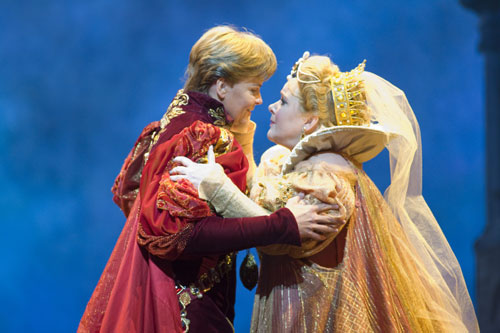 |
Baroque operas have made a huge comeback in the last two, three decades, partly because there are enough young voices with the right tessitura to sing the complicated ornamentations, enough countertenors and contraltos to bring back some of the glamour of the castrati era. The rare operatic joy of hearing and seeing every single role ideally cast nowadays happens most reliably in Baroque operas, and San Francisco’s Ariodante was no exception. The opera seria premiered in 1735 at Händel’s Covent Garden Theatre and even though it was a success, Ariodante has not been performed for two hundred years. The unusual dramatic form of this opera begins with a happy ending – princely Ariodante and his betrothed Scottish princess Ginevra are getting ready to marry. The second of three acts plunges the lovers into a major betrayal and almost tragic misunderstanding before a happy ending is once again restored. Both Ariodante and his rival, the villainous Polinesso, are sung by women, and these two women, especially Susan Graham in the title role, steal the show. Graham is gifted with a voice of amazing emotional flexibility and expression; she is a true actress both in her body and her voice, of noble bearing but capable of collapsing on the floor in the middle of an aria, rolling around and moving you to tears with her despair. Italian contralto Sonia Prina jumped in for the indisposed Ewa Podles and was utterly convincing as Polinesso, the rogue. San Francisco’s beloved Ruth Ann Swenson was a radiant Princess Ginevra. The direction by John Copland stayed out of the way and let Händel’s searing, darkly emotional music (conducted by Patrick Summers) shine – a perfect night at the opera.
Lucia di Lammermoor
Just as perfect and heart-wrenching was Nathalie Dessay in Lucia di Lammermoor, a belcanto opera composed by Donizetti exactly one century later. The story, based on Sir Walter Scott’s The Bride of Lammermoor, is a Scottish Romeo and Juliet. Lucia is secretly betrothed to her brother’s enemy Edgardo but is betrayed by her brother Enrico and forced into marriage with Enrico’s political ally. In what today would be called a psychotic break she stabs this unwanted husband on her wedding night, goes into a delirium (the famous Mad Scene) and dies of a broken heart. Grieving Edgardo kills himself.
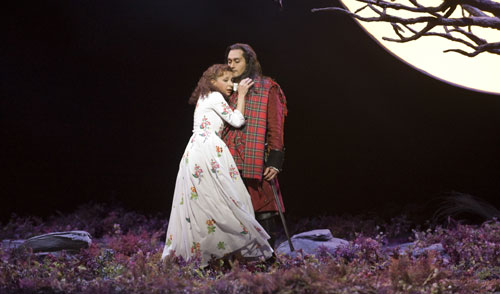
A superstar like Nathalie Dessay can easily undermine the ensemble effort of an opera, but in this case the marked difference of her style of acting was in thrilling service to the drama. Dessay is tiny, thin as a rail, and she played Lucia as a fragile girl who dreams up an impossible love with the impatience of bird fluttering in her cage. She is light as a feather, constantly on the move, skipping, turning, so much in motion and emotion that all the men on stage appear to be in an alien, hostile world. She is all alone in her vulnerable dream. In this production from the Maggio Musicale in Florence, Dessay is surrounded by two Italian singers with an old-world operatic style – tenor Giuseppe Filianotti as Edgardo and baritone Gabriele Viviani as brother Enrico. They basically don’t move, they stand and belt out their arias, but at the height of the drama both manage to drive themselves into hot passion and a thrilling climax. In a sensitive psychological touch by renowned director Graham Vick (with his assistant Marco Gandini) Lucia wanders off into the night for her Mad Scene, strips off the bloodied wedding gown and sings her ravings to the moon. Her utter aloneness (instead of the usual backdrop of the shocked wedding party) not only makes sense but also accords her an unusual dignity. The pure white of her simple undergarment beautifully reestablishes her innocence. Her broken mind’s eerie melodies are reflected in the accompaniment – not the usual flute this time, but the glass harmonica originally intended by Donizetti and played here on a modern version, a "verrophone". One could not imagine a more fitting musical metaphor for the heroine’s undoing than this ghostly sound of vibrating glass. Dessay’s clear lyric soprano is both delicate and strongly projected, with shimmering silvery colors and seemingly effortless coloratura trills and top notes. Her vocal fluidity and physical grace created an utterly original portrait of Lucia that will not be easy to forget.
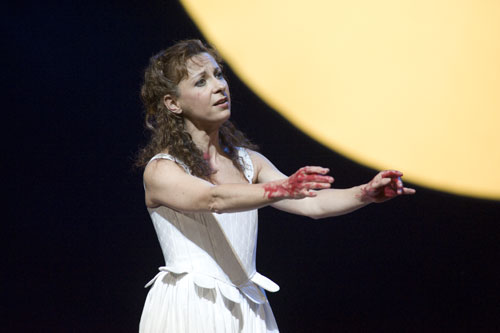 |
Das Rheingold
This first part (in fact the prelude) to a new Der Ring des Nibelungen cycle is a co-production between San Francisco Opera and Washington National Opera. Prolific American director Francesca Zambello’s intention is to create "the American Ring," to find places where "American images meet Wagnerian mythology". A tempting idea — after the countless interpretative modern stagings in recent decades that set the Ring anywhere in either post-atomic or other sci-fi landscapes, in totalitarian regimes or simply in today’s market-driven computer age (like the last SF Ring cycle). These modernisations are full of pitfalls, however, as sooner or later most of these interpretive tricks run smack against Wagner’s genius – his more coherent ("Gesamtkunstwerk") ideas and psychologically astute intentions. In this first part of the "American Ring", the zig-zag of good ideas and run-ins is almost immediate and continues to the final curtain.
Das Rheingold starts with the famous e-flat played by a specially outfitted bass and repeated by six more special basses and accompanied by horns in order to produce something like "Ur-Raunen" – the murmur at the beginning of time. For 136 measures, the full accord builds and swells to fill the entire theater with the enormous, enveloping sound of thirds cascading like a primordial river: the Rhine. The archetypal mood of this music powerfully evokes a mythical era, an era of gods, giants and gnomes (the first humans only appear in Die Walküre, the next opera of the cycle), and announces the trouble modern interpretations are inevitably going to encounter...
The way this opening was played in San Francisco this summer oddly underplayed the mythical: conductor Donald Runnicles snuck into the pit unnoticed and started the e-flat note while the house lights were still on and people were still chatting, until the musical murmur was loud enough to shut them up. Video projections then contradicted this casual start with a kind of thick cosmic brew, spirals turning and swirling, a few 2001 asteroids passing by, throughout the overture.
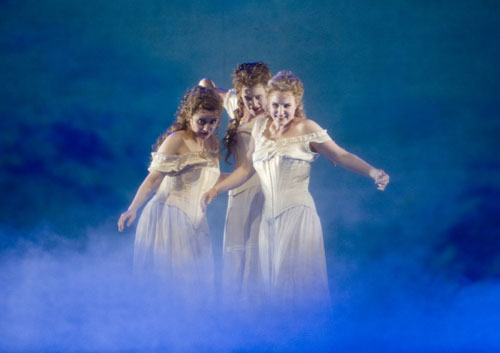 |
Finally, we arrive on earth: The scene opens to the beautiful video projection of a mountain torrent, with pretty, corseted Rhine Maidens frolicking in the (fog-machine) waves. (Why this traditional first scene image should particularly evoke an American wilderness, I don’t know.) Alberich, the ugly gnome, ruler of the dark underground realm of the Nibelungs, appears in the guise of a Californian gold digger, pan in hand (a chuckle of recognition in the audience). A superb scenic realization follows when Alberich (well sung and acted by Richard Paul Fink) grabs the gold from the Rhine Maidens – a huge, finely woven cloth of shimmering gold that floats between the singers and lifts into the air conveying the magic of this unspoiled treasure of nature.
As in a painting by Caspar David Friedrich, a wanderer in a stiff suit appears on a cliff above, watching the scene: the Fire God Loge (Stefan Margita) who will soon report to the Gods that a dangerous crime has been committed. Only a person renouncing love can rob the gold and form the ring of power that will govern the world – and whereas the highest God, Wotan, could never renounce his love and need for women, the Gods and the world are now threatened by a gnome clever enough to understand that without love there can still be sex – and rape. With this ominous beginning the major theme and plot of the Ring are set in motion: the quasi-cosmic battle, not simply of good versus evil, but with more sophistication, of power versus love.
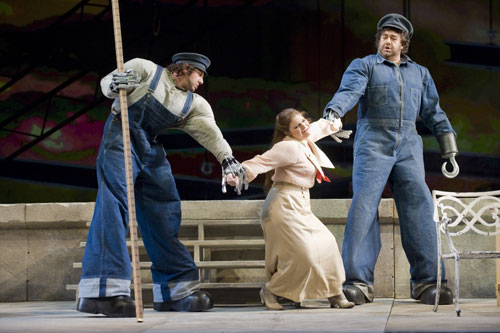
Following her California Gold Rush imagery, Zambello turns the Gods into a bunch of robber barons partying on their villa terrace above the clouds, but she does so without any social astuteness or bite. These capitalists convey neither charm nor danger, just the banality of the nouveau-riches. They are dressed and behave like insignificant fools at their afternoon cocktail (no barbecue, I noted, just a table with construction drawings). The Goddesses are simply women, mincing and wincing and insignificant. Wotan’s spouse Fricka is sung by mezzo Jennifer Larmore. Her voice strained and on the thin side, Larmore acted like a silly, hysterical trophy wife. One has to wonder how Zambello plans to transform Fricka into the formidable adversary of her husband, able to launch a successful (and fairly castrating) rebellion against him in Die Walküre. Just as misconceived is Freia (sturdy-voiced Adler Fellow Tamara Wapinski) in a frumpy schoolgirl-dress, unable to project anything of the goddess of love whose apples convey eternal youth to the Gods, and to anyone able to get hold of Freia. Which, of course, is precisely what the Giants are plotting.
The Giants, Fafner and Fasolt (Andrea Silvestrelli and Günther Groissböck), descend in an amusingly fitting way on a construction lift amid beams of steel as if they hadn’t just built the fortress "Walhalla" for the Gods, but a skyscraper. With their construction worker overalls and huge seven-mile-boots they are perfectly embodied. Wotan – in good patriarchal fashion – has offered them Freia as payment, hoping the Giants will be stupid enough to accept a different reward. If not, he plots, clever Loge will always find a way to get him out of his contract. No reward, however, is sweeter than a woman, the Loge tells him – unless it’s power. The ring of power, to be precise, which Alberich has just forged for himself.
The scene of Loge and Wotan’s descent to the Nibelungs is accompanied by the obvious cloud and rock video projections, but the underground realm of mining is well realized. Small-sized Asian and other ethnic slave laborers and child workers are Alberich’s minions who, in their terror of the ring, creep up steep ladders in the cave wall and hang there as in a painting of Hieronymus Bosch’s hell. If Alberich’s turning into a giant snake is a disappointing video trick, his stint as a frog – looking like a clumsy wind-up toy – is a joke and earned a snigger from the audience. But when Wotan (thanks to Loge’s cunning) overpowers Alberich, the imagery is stark and convincing: Alberich is tied up and wears a hood like an Abu Ghraib prisoner; the scene is plunged in grey light, with no colors left except the sparkling ring which now is stolen by Wotan and receives Alberich’s violent curse.
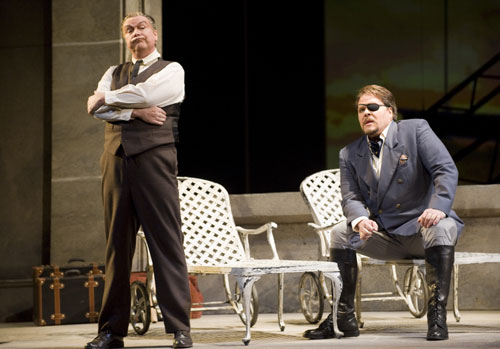 |
As usual in updated versions, Wotan in his banal modern attire casts a rather odd figure when he suddenly has to get his famous spear out to settle the mounting tensions with Alberich or the Giants. But even odder is the fact that this Wotan seems to have no other power than his anachronistic spear. This is San Francisco Adler Fellow Mark Delavan’s first Wotan and even though he has a pleasant baritone voice he lacks the vocal heft and authority to convey the charisma of this major hero/ anti-hero of the Ring. Wotan is a figure rich in contradictions and inner conflicts. Not unlike Wagner himself, he is irresistible, grandiose, proud, a masterful ruler and deceiver, a deep-feeling man. A good Ring production has to get the audience from the get-go onto the side of this (oh so human) scheming God and root for him. If one doesn’t fear for the Gods and the charming, threatened beauty of their reign, if one couldn’t care less about Wotan and the Gods, the Ring falls flat.
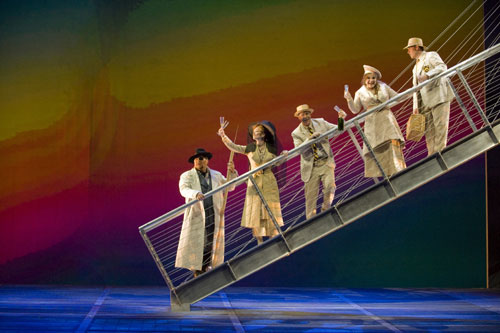 |
The true hero in this uneven production is Loge, brilliantly sung and acted by the rising Czech tenor Stefan Margita. With his high-ringing, beautiful voice and superb clarity of diction Margita played and sang Loge not so much as a Luciferan character, but as a truly modern cynic with a cabaret cool – which seemed, in this production, like a decidedly un-"American" act.
The ending of this Rheingold seemed rather absurd to me with Zambello’s idea of having Freia fall for the Giant Fasolt. In one moment, Freia has to see her darling die from the curse of the ring and, in the next, happily shriek and clink champagne glasses with her fellow Gods (who almost bartered her away to their enemies). Then they all ascend to their new abode. The "rainbow bridge" which Donner, the God of Thunder, sets up with his lightning strike, now is a steal bridge reminiscent of the walkways at Charles de Gaulle Airport.
The tenor of the local reviews was "Opera digs for gold (finds a bit)" (San Francisco Chronicle). I wonder, admittedly with a certain doubt, what Francesca Zambello will serve next in her "American Ring"? Will Wotan and Fricka be able to grow into their roles? Will the Walkyries be cowgirls on flying horses?
|

